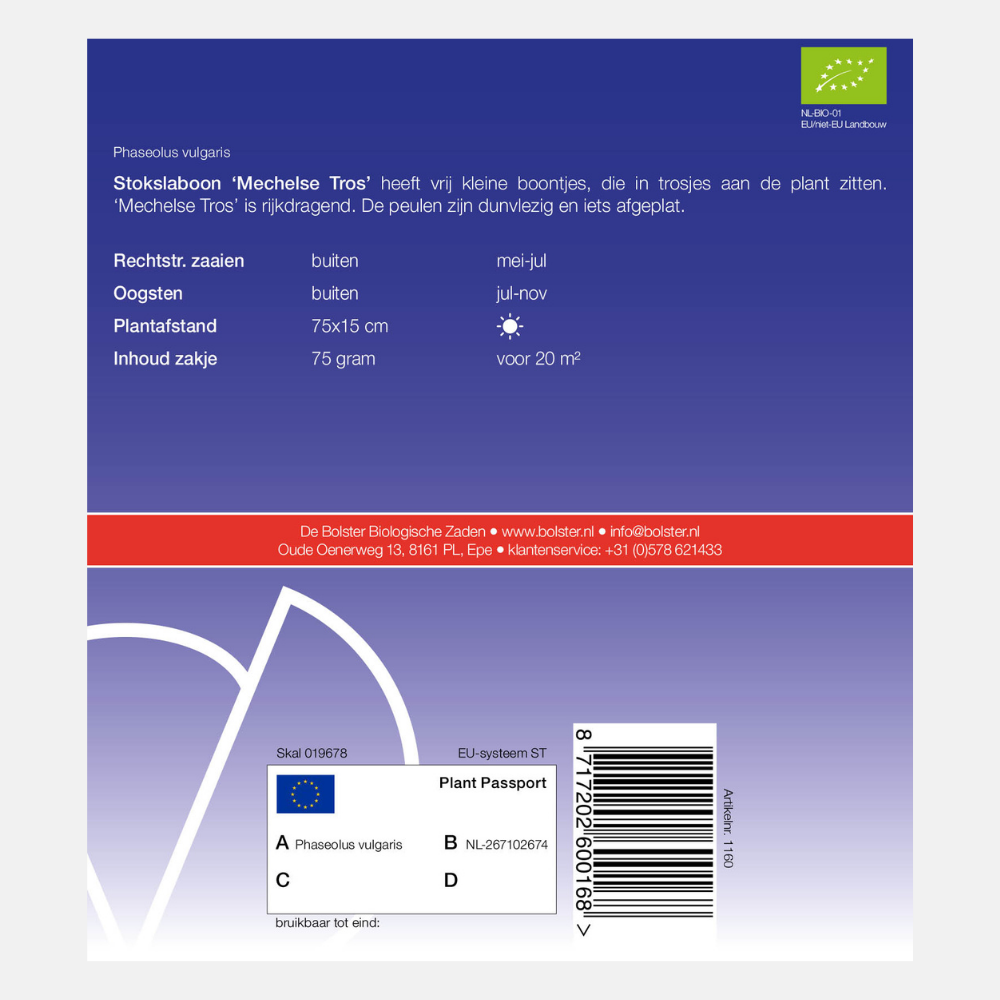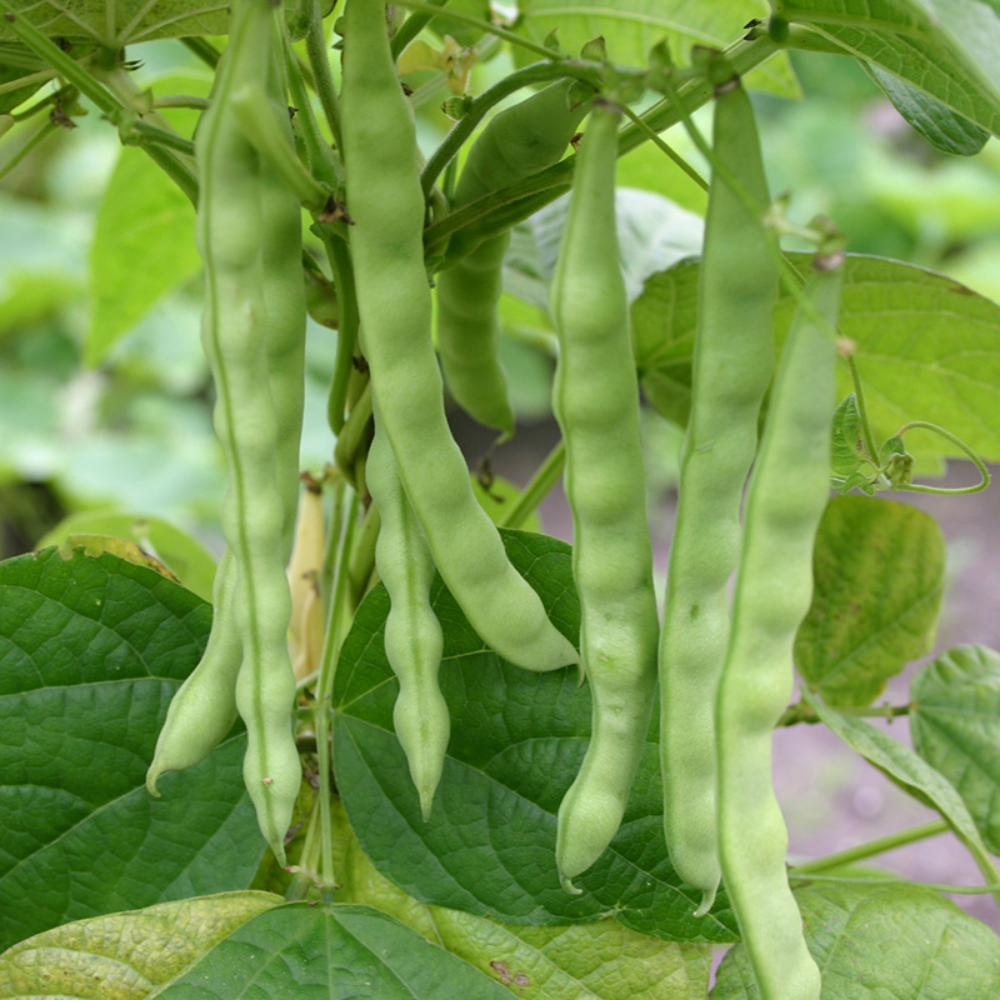Runner bean 'Mechelse Tros' BIO
As the name 'Mechelse Tros' already suggests, this pole bean is in bunches on the plant. Grow this bean in a sheltered place. In the greenhouse, one generally has an extra yield. One bag is for approximately 20m2, and the planting distance is 75x15 cm.
Pole bean 'Mechelse Tros' has fairly small beans, which are in bunches on the plant. 'Mechelse Tros' is a rich yielder. The pods are thin-fleshed and slightly flattened. Grow in a sheltered place. The harvest of pole beans starts somewhat later than with bush beans. Important advantages of pole beans: no problems with fungi (crop can dry out well), long harvest period and high yield. All pole beans have a 'nice climbing mechanism': whether it is diagonal, straight or twisted, always winding and always with right turns, the way to the top is found blindly. The material (bamboo poles, bean poles, ropes, etc.) that you use as material does not matter that much, but the whole must be sufficiently stable when fully loaded. In every allotment garden there is someone who can explain what the best system is. An old guideline, but still current, is to keep 8 to 10 plants per m². Sowing twice (mid-May and end of June) gives a good harvest distribution. 75 grams is sufficient for about 60 sticks. When growing in a greenhouse, you can also let the beans climb up a rope; for example, you attach the rope to a horizontally pulled steel wire. This saves you from having to build a construction of sticks. Growing pole beans in a greenhouse generally gives an extra yield.
- Biologisch
- Yes
- Merk
- The Bolster
- Type en soort
- Open-pollinated variety
- Standplaats
- Sun
- Zaaien
- May June July
- Planttijd
- May June July
- Oogst- en bloeitijd
- July August September October November
- Rijafstand
- 75 cm
- Plantafstand
- 15 cm
- Hoogte
- 250 cm
- Inhoud
- Approx. 352 seeds
Runner bean 'Mechelse Tros' BIO is backordered and will ship as soon as it is back in stock.
Couldn't load pickup availability
Dispatch
Dispatch
We ship your order within 1-2 business days*. When you spend €75,- you get one free shipment. Shipping is possible from €3.95. All orders are shipped as a package with a track and trace code, so you can always follow your order. Read more about the shipping costs in our FAQ.
Delivery time pre-order
Your order will be shipped from the indicated availability date. This also applies if you combine pre-order with products that are already in stock.
*Please note: In some cases this is not the case, such as: pre-orders, chicory roots, trees and small fruit. Read more in our FAQ.
The Bolster
The Bolster
Pioneer in organic seeds
De Bolster has been the specialist in 100% organic seeds for 45 years, with a focus on sustainability and future-proof agriculture. They produce seeds of more than 330 varieties, from vegetables and flowers to green manures, at international locations and completely GMO-free. With organic breeding methods and a commitment to variety freedom, they work together with professional growers and hobby gardeners to make organic cultivation accessible to everyone. Since 2023, they have been operating as a cooperative, to increase the impact of organic farming together with customers and suppliers. Their dream? A healthy planet with 100% organic farming.
Explanation of resistances
Explanation of resistances
Our seeds are provided with different resistance codes. In this PDF you will find a clear explanation of all codes and their meaning.
Different types of seeds
Different types of seeds
What is the difference between organic, F1 hybrid, heirloom (open-pollinated), GMO, pill and conventional seeds? We explain it to you in this blog !
Saving seeds
Saving seeds
Store seeds in a cool, dry and dark place, such as a sealed box in a cupboard. Pay attention to the expiration date on the packaging and use them before that time. If the packaging has been opened, make sure it is sealed properly and check the germination capacity before use.
You can easily test the germination capacity of seeds with a germination test :
- Place a few seeds (for example 10) on a damp piece of kitchen paper.
- Fold the paper towel closed and place it in a plastic bag or place it in a sealed container.
- Place it in a warm place, such as on the windowsill.
- After a few days, check to see if the seeds have started to germinate.
Basic sowing guide
Basic sowing guide
First time sowing? No problem! Our basic sowing guide will briefly explain how to get started. Also take a look at our extensive growing guides for specific tips per plant species - super handy if you want to know exactly how to grow aubergine or garlic, for example 🌱.








